 |
A week of strange sightings. The Debt Deflation Bear Market that started in the final week of 2007, the first bear market iTulip has called since April 2000, rallied twice this week on two items seen floating in the sky and taken as a positive omen by believers. One, rising inflation as reflected in increased retail spending is good for the economy and, two, a one week 2.9% drop in new unemployment claims means the economy is out of the woods.
Later in the week Ben Bernanke testified before Congress that the objects were nothing to get excited about. The economy is in need of further stimulus because the it's getting worse. That said, for reasons he does not explain he also said he is nonetheless optimistic. His contradictory statements sent the markets tumbling. Today a New York Federal Reserve regional manufacturing survey indicated that conditions deteriorated this month, and the preliminary Reuters/University of Michigan survey on consumer sentiment for February showed a significant decline from the prior month. A Labor Department's report found that import prices are rising precipitously.
Rising prices and falling economic activity? Stagflation. Who could have known?
Inflation is not economic growth
Retail Sales Surprisingly Strong in January
February 13, 2008 (Martin Crutsinger, AP Economics Writer)
Retail Sales Rebound in January After Dismal December, Strength Led by Higher Gasoline Costs
WASHINGTON (AP) -- Retail sales posted a surprising rebound in January following a dismal December, although much of the strength reflected rising gasoline prices. Economists saw the increase as a temporary blip rather than a sustained recovery.
The Commerce Department reported Wednesday that retail sales rose by 0.3 percent last month after having fallen by 0.4 percent in December as retailers suffered through their worst Christmas shopping season in five years. The increase was led by higher demand for new cars and a big jump in sales at gasoline service stations that primarily reflected rising pump prices.
On Wall Street, the better-than-expected reading on retail sales helped lift spirits by easing concerns about the severity of the economic slowdown. The Dow Jones industrial average rose 178.83 points to close at 12,552.24.
The first Unidentified Financial Object was inflation that stock market bulls mistook – again – for economic growth. While the January retail “growth” was reported as a “surprise” the real surprise was December 2007 when in spite of a spike in inflation nominal retail sales growth was still off. To its credit, the mainstream business press is catching on to the real versus nominal growth reality and most stories on this month’s retail numbers noted that the rise in gasoline prices that made up the bulk of the “growth” does not make a consumer rebound. In our opinion, it makes for further consumer retrenchment; inflation is a major source of the economy’s problems, not its savior, and added stimulus will further increase the burden of the Inflation Tax in consumers (see Reflation without Representation).February 13, 2008 (Martin Crutsinger, AP Economics Writer)
Retail Sales Rebound in January After Dismal December, Strength Led by Higher Gasoline Costs
WASHINGTON (AP) -- Retail sales posted a surprising rebound in January following a dismal December, although much of the strength reflected rising gasoline prices. Economists saw the increase as a temporary blip rather than a sustained recovery.
The Commerce Department reported Wednesday that retail sales rose by 0.3 percent last month after having fallen by 0.4 percent in December as retailers suffered through their worst Christmas shopping season in five years. The increase was led by higher demand for new cars and a big jump in sales at gasoline service stations that primarily reflected rising pump prices.
On Wall Street, the better-than-expected reading on retail sales helped lift spirits by easing concerns about the severity of the economic slowdown. The Dow Jones industrial average rose 178.83 points to close at 12,552.24.
Labor market is not recovering
The second UFO to appear this week was a small drop in unemployment claims that stock bulls interpreted as good news about the nation’s labor market.
Stock Prices Are Mixed on Jobless Claims
February 14, 2008 (Tim Paradis, AP Business Writer)
Stocks Slip As Investors Await Testimony From Bernanke, Paulson; Unemployment Claims Decline
NEW YORK (AP) -- The Labor Department's report that the number of workers seeking unemployment claims fell by 9,000 to 348,000 last week eased some concerns about the state of the labor market. Wall Street has worried that consumers are turning cautious amid a slowdown in the housing market, mounting debt loads and rising prices for fuel and food. Consumer spending is critical for economic growth.
A 2.9% one week decline off of a weekly rate of 348,000 is nothing to cheer about. A much more faithful indicator of labor market strength is median duration of unemployment (MDU). We used it to help confirm our recession forecast and it’s still showing the classic signs of an early recession, so we've modified the chart to show the current recession. February 14, 2008 (Tim Paradis, AP Business Writer)
Stocks Slip As Investors Await Testimony From Bernanke, Paulson; Unemployment Claims Decline
NEW YORK (AP) -- The Labor Department's report that the number of workers seeking unemployment claims fell by 9,000 to 348,000 last week eased some concerns about the state of the labor market. Wall Street has worried that consumers are turning cautious amid a slowdown in the housing market, mounting debt loads and rising prices for fuel and food. Consumer spending is critical for economic growth.
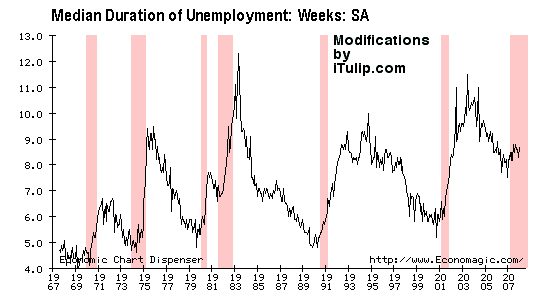
MDU is a function of falling net job creation. Before businesses lay people off they freeze hiring. Early in a recession workers lose jobs at the same rate as during expansion but fewer new jobs are created so it takes the average worker longer to find a new job. The MDU spike is caused later in the cycle when the rate of job losses is rising and at the same time the rate of new job creation is falling. Offshoring that's driven during a recession by the need for companies to reduce payroll expenses without a corresponding reduction in output results in a structural change in the affected industry, to wit: the offshoring of computer hardware jobs after the 2001 recession sent jobs overseas that never came back.
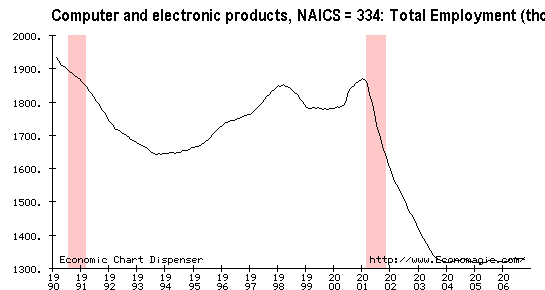
Just as some iTulipers were starting to wonder if maybe we’d gotten our Debt Deflation Bear Market call wrong because the market appeared to be recovering, along comes Bernanke to throw a bucket of cold water on it.
Bernanke Says Economic Outlook Is Worse
February 14, 2008 (Jeannine Aversa, AP Economics Writer)
Fed Chairman Bernanke Says Nation's Business Prospects Have Deteriorated
WASHINGTON (AP) -- Federal Reserve Chairman Ben Bernanke told Congress Thursday the economy is deteriorating and signaled a readiness to keep on lowering a key interest rate to shore things up.
His comments sent the DJIA down over 170 points, but the dollar went down even more and that means more inflation in our future. Platinum, for example, hit $2,051 per ounce in response. February 14, 2008 (Jeannine Aversa, AP Economics Writer)
Fed Chairman Bernanke Says Nation's Business Prospects Have Deteriorated
WASHINGTON (AP) -- Federal Reserve Chairman Ben Bernanke told Congress Thursday the economy is deteriorating and signaled a readiness to keep on lowering a key interest rate to shore things up.
Quick platinum tale of woe that I hope is instructive. I purchased 100 ounces of platinum in 2001 at around $450 and cleverly – or so I believed at the time – sold 80% of it four years later in 2005 when the price spiked to $1,200. After a near 300% rise in a few short years, the general consensus at the time was: platinum is overpriced. Then the price went over $2000.
The lesson is: When declining demand for money not rising demand for a commodity is driving prices, it’s easier to make the mistake of selling too early than selling too late. That mistake only cost me $68,000 so far, and I have not made it with respect to silver and gold purchases. A friend who runs a major gold fund told me over dinner earlier this week, “In this environment if you sell too soon you can get wiped out; the purchasing power of the cash you earn from selling too soon can fall 50% in a short time, wiping out your previous gains.” He expects gold to go to $10,000. He’s a professional but as I’ve mentioned over the years, it’s just as hard for pros, especially young ones, to avoid getting caught up in the genius of their recent trades as it is for amateurs.
Maybe now platinum is "too high" or the dollar is "too low"? Depends on more buyers at higher prices in the future, of course. We are told that greed and fear drive the markets. I don't buy it. Fear and fear drive the markets: fear of losing money and fear of losing out on gains. A market is in balance when there are as many people afraid to sell as are afraid to buy at the current price.
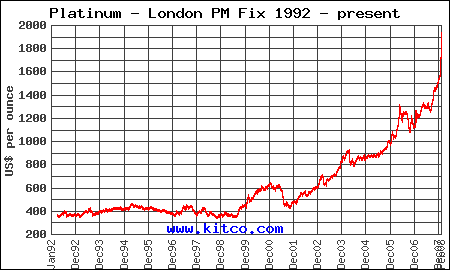
All this talk about recession got me thinking: does it ever happen that the business media talks a lot about recession when there's no recession? Turns out that according to research by Kevin Kleisen over at the St. Louis Fed last May the answer is “no.” He did an analysis Recession Rumbings (pdf) to find out if a meaningful correlation exists between the incidents of stories in the business press that use the word "recession" and actual recession. Here’s the chart with his conclusions.
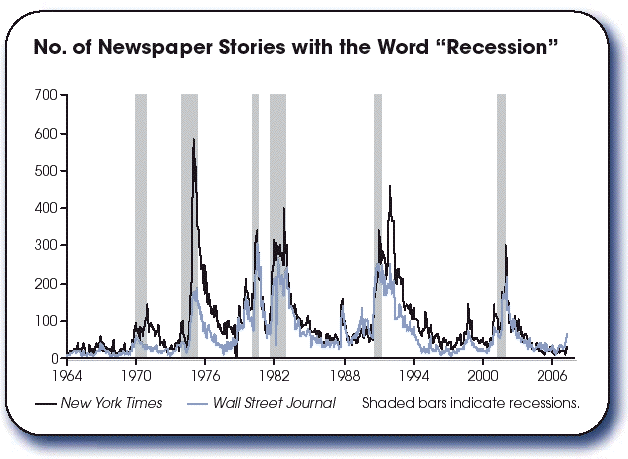
There are a few things to notice in the chart: First, “recession” stories seem to exhibit normal business cycle characteristics; the number of stories rises during periods of slow growth and recession and remains low during periods of economic expansion. Second, recession stories seem to peak toward the end of the recession, or shortly after, and then fall sharply—which suggests that this indicator might be useful in helping identify troughs, though perhaps less so for peaks. Third, although the two newspaper counts show a high degree of correlation (0.86), the number of recession stories that appear in the New York Times is usually larger than the number that appear in the Wall Street Journal. This was particularly evident in the 1973-75 and the 1990-91 recessions. Finally, despite a noticeable jump in the number of “recession stories” in the Wall Street Journal in March 2007, both series remain at levels consistent with economic expansion. —Kevin L. Kliesen
That was back in May 2007. Where are we today in the recession talk cycle? Counting Wall Street Journal and New York Times mentions of the word “recession” is the old fashioned way. Let’s use google.com/trends instead.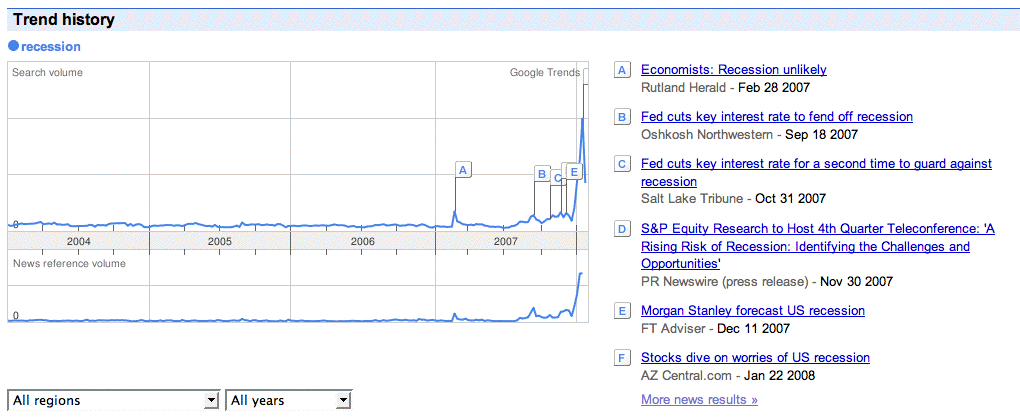
Looks like recession to us. As unemployment rises we expect the recession talk trend to continue all year.
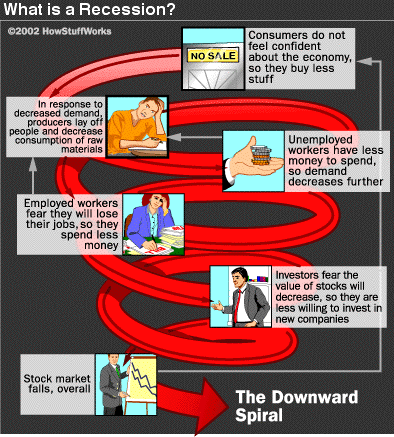 |
We can observe the mis-comprehension at sites like http://www.howstuffworks.com that attempt to explain how recessions work. To the left is the howstuffworks graphic that shows the self-reinforcing nature of a recession as an economy spirals down. The traditional Keynesian explanation is that the recession cycle starts with a dispirited Joe Consumer losing confidence in the economy and so he stops buying so much stuff, then he gets laid off, then he spends even less as his income disappears, then his friends and neighbors hear about his plight and they start to lose confidence, too, then investors bail on the economy and stocks, the stock market goes down, leading to further loss of confidence.
The problem with this explanation is that it does not explain why Joe lost confidence in the economy in the first place. Are the newspaper stories he’s reading about recession causing him to lose confidence or did the recession that the papers are writing about cause him to lose his nerve? The Keynesian explanation is tautological.
Our take is that every recession is different and this one is more different than all of the others. It’s the result of several unique factors and some not so unique factors feeding into each other. I leave you with the iTulip version and bid you and your family an enjoyable weekend, recession or not.
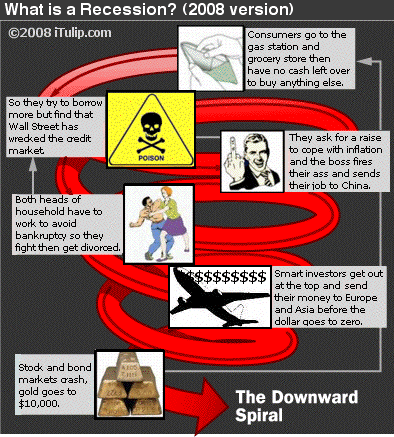
iTulip Select: The Investment Thesis for the Next Cycle™
__________________________________________________
To learn about the Next Bubble, sign up for one year of iTulip Select by February 29 and receive the February 2007 issue of Harper's Magazine with Eric Janszen's cover article The Next Bubble free.
For the safest, lowest cost way to buy and trade gold, see The Bullionvault
To receive the iTulip Newsletter or iTulip Alerts, Join our FREE Email Mailing List
Copyright © iTulip, Inc. 1998 - 2007 All Rights Reserved
All information provided "as is" for informational purposes only, not intended for trading purposes or advice. Nothing appearing on this website should be considered a recommendation to buy or to sell any security or related financial instrument. iTulip, Inc. is not liable for any informational errors, incompleteness, or delays, or for any actions taken in reliance on information contained herein. Full Disclaimer
__________________________________________________
To learn about the Next Bubble, sign up for one year of iTulip Select by February 29 and receive the February 2007 issue of Harper's Magazine with Eric Janszen's cover article The Next Bubble free.
For the safest, lowest cost way to buy and trade gold, see The Bullionvault
To receive the iTulip Newsletter or iTulip Alerts, Join our FREE Email Mailing List
Copyright © iTulip, Inc. 1998 - 2007 All Rights Reserved
All information provided "as is" for informational purposes only, not intended for trading purposes or advice. Nothing appearing on this website should be considered a recommendation to buy or to sell any security or related financial instrument. iTulip, Inc. is not liable for any informational errors, incompleteness, or delays, or for any actions taken in reliance on information contained herein. Full Disclaimer

Comment